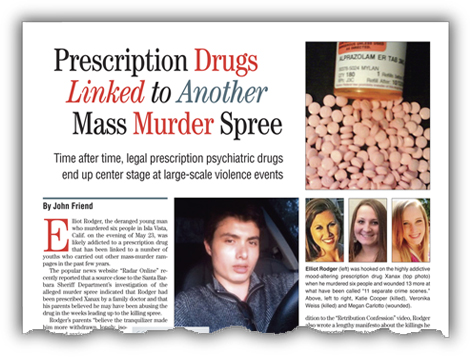
• Time after time, legal prescription psychiatric drugs end up center stage at large-scale violence events.
By John Friend —
Elliot Rodger, the deranged young man who murdered six people in Isla Vista, California on the evening of May 23, was likely addicted to a prescription drug that has been linked to a number of youths who carried out other mass-murder rampages in the past few years.
The popular news website “Radar Online” recently reported that a source close to the Santa Barbara Sheriff Department’s investigation of the alleged murder spree indicated that Rodger had been prescribed Alprazolam, whose trade name is Xanax, by a family doctor and that his parents believed he may have been abusing the drug in the weeks leading up to the killing spree.
Rodger’s parents “believe the tranquilizer made him more withdrawn, lonely, isolated, and anxious,” Radar Online reported.
Xanax is typically prescribed to treat anxiety, panic disorder and depression, and is highly addictive, and its users regularly become dependent on the drug and are warned not to stop using it suddenly.
Many independent researchers and investigative reporters believe addictive pharmaceutical drugs often play a decisive role in mass murders, especially among youths. In the past, many individuals who have gone on shooting rampages have been discovered to have been addicted to or severely impacted by pharmaceutical drugs.
“Xanax isn’t being blamed for causing Elliot to go on his rampage, but it probably wasn’t the best decision to have someone like him on it,” the law enforcement source explained to a reporter for the news website.
According to official reports, Rodger stabbed and killed his three roommates around 9:20 p.m. on May 23 before opening fire near the University of California-Santa Barbara campus, murdering three more individuals. Rodger later took his own life after crashing his car.
Rodger, the son of Hollywood movie director Peter Rodger, released a video on the Internet shortly before his alleged murder spree entitled “Retribution Confession.” In the video, Rodger specifically indicates he will be targeting “blonde sorority girls,” who have rejected him, even though he is a “superior alpha male,” according to the video.
“College is the time when everyone experiences those things such as sex and fun and pleasure,” Rodger states in the video. “But in those years I’ve had to rot in loneliness. It’s not fair. You girls have never been attracted to me. I don’t know why you girls aren’t attracted to me. But I will punish you for it.”
Prior to the killings, Rodger had made other videos and posted regularly on Internet forums, often complaining about his failure to find a girlfriend and develop a meaningful relationship. In addition to the “Retribution Confession” video, Rodger also wrote a lengthy manifesto about the killings he would reportedly go on to commit.
According to Alan Shifman, the Rodger family attorney, the 22-year-old was being treated by multiple therapists for mental health issues. In the month leading up to the alleged murder spree, police even came to Rodger’s apartment to check on him at the request of family members who were concerned about his mental health.
Following the visit by police officers, Rodger wrote the 141-page manifesto detailing his plans and expressing relief officers did not check his apartment where they would have apparently found his weapons and writings.
In typical fashion, politicians, victims’ family members and other anti-Second Amendment activists have used the tragedy in Santa Barbara to advocate and justify a crackdown on private gun ownership.
What is ignored is Rodger’s likely dependence on a dangerous—yet legal—pharmaceutical drug that has been a factor in murder sprees perpetrated by many young alienated individuals.
John Friend is a California-based writer who maintains a blog.

